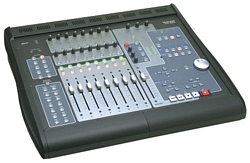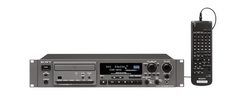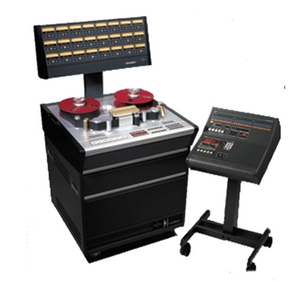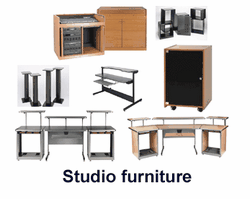The magic of the recording studio has often mystified even the most seasoned professionals. With all the knobs, switches and buttons on various gear and large format consoles, no wonder confusion sets in to most non-techies. Many people, especially artists, composers, producers, and engineers, will end up putting together their own studio for writing and preproduction, with some eventually deciding to take the plunge and create a full-fledged recording complex that is capable of recording major albums. This series of articles will try to shed some light on the considerations to take into account when making a studio, be it a small home studio or a professional recording studio.
 |
Is bigger better?
Is size important? Some may say it is so but this is not always the case. The dimensions of the studio are very important. A room too large may become over-reverberant or full of unwanted echoes. A room too small may sound tight and unnatural. It is important that the room size and room sound is relevant to the type of music you are recording. You don’t want to go into a very small tight room to record BIG rock drums. Although, big room sounds can be achieved by adding external reverb effects to simulate rooms at a later time when necessary.
It is best to find the room that suits the sound you are trying to achieve from the beginning of the recording process. The smaller the room, the smaller and tighter the sound will be; this is not necessarily a bad thing. Small tight rooms can be good for vocals, guitars and percussion if you are going for a tight clean sound. Larger rooms have more air for the sound to travel in, so it will be in fact a bigger more open sound. The sound has a longer travel time for the sound wave to move, therefore the reflection from the walls will take longer to bounce back creating a bigger more spacious sound. The decision of size and sound has to be made early on before the recording starts. One advantage that a larger room will have is the ability to be scaled down by closing up the room using modular baffles or gobos (go betweens). Gobos are structures that are partitions, that help to block sound by placing them in between the musicians, instruments, and microphones. Placing the gobos around the microphone at a close distance will help a large room with too much ambiance sound smaller. This will eliminate the reflections coming off of the walls that are further away.
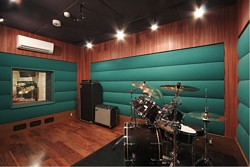 |
Small rooms can produce big heavy tight sounds with the absence of the decay from the reverb that is caused from big rooms. Sometimes a large room can sound like it’s washed out, or far away. With a good engineer any room can sound amazing with a little adjusting. A poor sounding room can be manipulated to sound good, although it requires much more work and time. Deciding on the proper room size for your needs is critical to the sounds that get re-produced. This will highly dictate the type of sound the microphones will pick up.
Clapping your hands in a room can give a good representation of what a room will sound like. The reflection coming off the walls will be picked up by a simple hand clap. The true test is to try out some instruments or vocals and position them in various sections of the room until reaching the optimum sound quality. If one side of the room sounds bad try a different spot or move around into a corner until the sound is improved.
Experimenting with different sections of the room also keeps the sound fresh when recording many instruments. If the acoustic guitars are recorded in the center of the room, when the time comes to record the electric guitars you may try recording them in a corner of the room for a different room sound. This gives clarity on the final mix creating separation and providing more distinction on various sounds.
If you are starting your own studio, remember that the bigger the studio the higher amount the bills will be. The benefit is that larger studios can charge more for their studio rates.
Getting the Necessities
If you happen to reach that elite 2% and become that million dollar, hit selling, famous producer or artist (or if you just win the lotto), then you might eventually think about buying serious studio gear and setting up your own producer paradise.
Acquiring the proper equipment and labor is key to a great studio and successful recordings. Studio gear is expensive and the knowledge of those who use the gear does not come cheap. Hiring the right people can save money and time in the long run. Studio designers also are specialty breeds that can make or break your studio. Your buddy Joe the carpenter may be able to help build it for less, yet if the studio is not properly isolated for sound it is a great waste of time, energy and finances.
The studio engineer is also the focal point of the sound that is created. Having an experienced engineer involved in the process will make your sound have a character of its own. He is the extra set of ears that gives another dimension to your productions. He is also a critical consulting partner when building or choosing to rent a studio. Let the experts help you with advice, it will create less of a headache in the long run. The experienced engineer can fill you in on all the equipment needed for recording the music that is relevant to your world. He can also give some guidelines on how the studio should be setup before having to consult a designer. There is no room for guessing or assumption on these issues.
The Pros
Professionals, of course, should be consulted whenever possible in order to get the necessary elements together for any proper situation. It’s not uncommon to see engineers and musicians ending up making the transition to producer.
Some of the most recognized engineer/producers include:
George Martin- The fifth member (engineer / producer / arranger) of The Beatles. Owner of Air Lyndhurst studios in London. Helped to bring multi-track recording into the forefront. Celine Dion, UFO, America, Jeff beck, Mahavishnu Orchestra, Little River Band, Gerry and the Pacemakers, Cheap Trick, Earth Wind and Fire, Cilla Black, Kenny Rogers…
Eddie Kramer- One of the most respected engineer / producers in rock music. Studied classical piano, cello and violin as a young child in South Africa. Led Zeppelin, Jimi Hendrix, Kiss, Sammy Davis Jr., The Kinks, Traffic, The Beatles, The Rolling Stones, The original Woodstock concert soundtrack, Anthrax, Whitesnake, Buddy Guy…
Tom Lord-Alge– “The Doctor of Spank”. Spank refers to compression. Avril Lavigne, Pink, Fall Out Boy, Blink 182, Phil Collins, Santana, Faith Hill, Backstreet Boys, Marilyn Manson, Carly Simon, Good Charlotte, Dave Matthews, Sum 41, Hole, Annie Lennox, Sarah McLachlan, 30 Seconds to Mars, The Wallflowers, Weezer, Everclear, Yellowcard, Third Eye Blind, OMD, Steve Winwood, Foreigner, Chaka Khan, Tricky, Eve 6, Live, Fuel, New Found Glory, No Doubt, M2M, Lisa Marie Presley, Mick Jagger, The Rolling Stones, Liz Phair, Limp Bizkit, The Verve Pipe…
Chris Lord-Alge- My Chemical Romance, ”Transformers” the movie, Green Day, U2, Tina Turner, Santana, AFI, Pink, Tim McGraw, Enrique Iglesias, Rob Zombie, Cortney Love, Prince, Pussycat Dolls, Stevie Nicks, Hoobastank, Joe Cocker, The Used, Stone Temple Pilots, P.O.D. Johnnie Lang, H.I.M., Jewel, Michelle Branch, 30 Seconds to Mars, Breaking Benjamin, Expose, Collective Soul, Switchfoot, Randy Travis, Melissa Etheridge, All American Rejects, The Donnas, Pepper, The Black Crowes…
Tony Visconti- David Bowie, Morrisey, T-Rex, Ziggy Marley, Thin Lizzy, The Moody Blues, Badfinger, Adam Ant, Squeeze, Briam Eno, Iggy Pop, The Alarm …
George Massenburg- 10,000 Maniacs, Aaron Neville, Bonnie Raitt, Cher, Dolly Parton, Earth, Wind and Fire, Herbie Hancock, James Taylor, Journey, Kenny Loggins, Linda Ronstadt, Little Feet, Ry Cooder, Ricky Scaggs, The Emotions, Toto, Tower of Power, Weather Report. George Massenburg is also the creator of one of the worlds best EQs by George Massenburg Laboritories(GML).
Ed Cherney-Paula Abdul, Billy Joel, The Rolling Stones, Eric Clapton, Bob Dylan, Neil Diamond, Bob Seger, Michael Jackson, Bonnie Raitte, The Knack, The GooGoo Dolls, Iggy Pop, Crosby Stills Nash and Young, Elton John, B-52s, The Ohio Players, Travis Tritt, Wynona Judd, Jackson Browne, Barbara Streisand, Tenacious …
Sylvia Massey Shivy- One of the industry’s top female engineer / producers. Dishwalla, Seven Mary Three, Powerman 5000, System of a Down, Sevendust, Melissa Etheridge, Rage Against the Machine, Bjork, Foo Fighters, Fugees, Blur, Beck, Alanis Morrisette, Patti Smith, Smashing Pumpkins, Luscious Jackson, Oingo Boingo, Slayer, Donovan, Red Hot Chili Peppers, Tool, Prince, Fishbone, Ziggy Marley, Jefferson Starship, Tom Jones, Elton John, The Time, OMD, Babyface, Lisa Haley, Johnny Cash, Tom Petty, Beastie Boys…
Hugh Padgham- David Bowie, Genesis, Sting, The Police, Phil Collins, Melissa Ethridge, Bee Gees, Elton John, Sheryl Crow, to name a few.
Check List: Part 1
When purchasing studio gear it is wise to research only what is absolutely essential for your style of music. If you’re not recording live drums in your studio, there is no need to buy a plethora of microphones for them. By being patient and shopping around for the best prices, a mass amount of money can be saved in the end. When you save $50 to $100 bucks on each piece of gear it really adds up in the end, and there is a ton of gear needed to put a proper studio together.
Below is a basic studio checklist that will be discussed in further detail in later articles. These are the essentials of modern day recordings and the tools that are most commonly used in the best studios around the world.
THE STUDIO GEAR CHECKLIST:
RECORDING / MIXING CONSOLE
The engineer or producer operates the console that controls all of the levels for recording, playback and mixing.
This is the big board that has all the buttons, switches, knobs, faders which control the levels and signal routing for each instrument. This could be referred to as a board, console or mixer. The most common consoles in major studios are SSL (Solid State Logic) or Neve. The console is the most important piece of gear in the studio. It controls the overall operations of signal flow and sound manipulation. The console allows for each instrument to be on its own channel on the board. Each channel may then have effects inserted into its signal path to enhance the sound. A signal may also be routed to external gear for further manipulation. Anything that can be imagined, can be done. There are no rules for experimenting with sound. A signal can be sent to reverbs, delays, compressors, guitar amps, speakers in hallways for re-recording
|
Channel Strips |
Each channel strip on a decent console will contain: Faders, Preamps, Panning, Equalization, Filters, a Routing Matrix, AUX Sends and Returns, Dynamics, Muting, & Solo.
Other Features Of The Console: Inserts, Outputs, Monitoring, Automation, Fader Grouping, Bussing, Splitting…
|
|
PATCHBAY
Allows the studio to combine interconnectivity with all the equipment by using patch cables. The patchbay can be configured for each studio’s specific equipment requirements. All of the outboard gear, console and recording devices inputs and outputs are hard wired to the patchbay. The Patchbays can be be analog or digital. The most common is the bantam TT cable configurations.
Check List: Part 2
MICROPHONES
Microphones pickup the initial sound source. The mic is the first source in the recording process receiving and converting the sound wave into electrical energy to be amplified, transmitted and recorded.
PREAMPS
Amplifies the original signal coming from the mic or instrument. Gives initial control of the recording levels. Preamps are located on the console or as external outboard gear.
|
|
DI BOXES
The Direct box is used mainly for instruments such as keys and bass to be compatible with mic inputs. The DI box transforms line levels of instruments to mic level for console and preamp inputs.
COMPRESSORS
Helps to further control levels and dynamics coming from the preamp or console. Usually comes in rack mounted outboard gear or software plugins for DAWs. Compressors keep levels from peaking into distortion levels and help to bring lower levels louder.
FX PROCESSORS
For special effects like adding space, dimension, pitch and time delays on signals and recorded tracks. Usually comes in rack mounted outboard gear or software plugins for DAWs. Multi-FX processors may have reverb, delay, flangers, EQ, compression and more all in one unit.
|
|
FX PEDALS
Small floor foot pedals originally designed for guitar FX processing. These pedals are created for distortion and special effects, which add space, dimension, pitch and time on guitars mainly, but are an inexpensive alternative used as outboard gear for other instruments.
DAW
The Digital Audio Workstation is like an entire studio inside of a computer. Protools, Logic and Nuendo are just a few DAWs that provide a digital multi-track recorder, a virtual console, a wide variety of effects, editing, and sequencing(musical programming) possibilities. The DAW uses software, hardware and computers in combination to operate.
CONTROL SURFACE
The control surface acts as a console that controls a DAW or external machine. The control surface usually has faders, knobs and buttons that are controlled by the computer connected to a DAW. This makes operating the DAW similar to analog operations by being able to put your hands on faders instead of clicking a mouse. Some control surfaces have all the same features as a console. The most common control surfaces are made by Digidesign.
CLOCKING
Digital recorders use different clocking formats to operate properly. Digital units sample the sound to be replicated. Clocking refers to the amount of time in between samples taken for reproduction. If the digital clocking is off it will sound jittery or add noise to the sound in the analog to digital conversion. A quality clock will improve the sound. Some common digital clock sources can be found in products made by Prism, Rosendahl, DCS, and Aardsync to name a few. Some clocks have sync generators built in to lock up with other machines.
SYNC GENERATOR
Generates tones to allow communication between machines so that several recording devices can be synchronized together and operate at the same speed. Clocking works with synchronization (sync) when analog and digital equipment is combined. Sync uses SMPTE, MTC (midi time code), Midi Clock, MMC (midi machine control) to allow recording on several DAWs and tape machines to be linked up together.
Check List: Part 3
CD RECORDER
Records and plays back compact discs. Gives the ability to record stereo mixes and playback these mixes on other CD players. CD standard for consumer playback is a sample rate of 16 bit and a sampling rate of 44.1kHz. Sony, Tascam, Alesis, and Yamaha all make good studio CD recorders.
TAPE MACHINES
Recording machines that use analog or digital tape for recording and playback of music. Some purists in sound recording prefer the sound of analog tape. There are many digital tape machines used for recording both music and video.
CABLING
Literally miles of various cabling could be needed for a single studio. Common cables in sound reproduction are XLR balanced mic cables and Unbalanced 1/4 inch instrument cables.
MONITORS / AMPS
Speakers in the studio are referred to as Monitors. Powerful clean amps are needed to run monitors. Many monitors are self powered, which means that they have built in amplifiers. Monitors usually consist of high frequency tweeters, low frequency woofers and cabinets that contain the speakers and components.
HEADPHONES / DISTRIBUTION
By using a set of earphones this allows communication between the control room and the studio, also allows pre-recorded tracks to be heard during the overdubbing process. Headphones are also referred to as cans.
INSTRUMENTS / KEYBOARDS / DRUMS / GUITARS
These are more of the tools of the craft. You may have all the best studio gear in the world, but if the instruments sound bad you are starting in the wrong place. Anything could be considered an instrument if it makes noise that could possibly be recorded on a record.
AMPLIFIERS
This is often referred to as an amp. Amps increase the amplitude or volume of electrical signals from sound waves. These are used in powering speakers. Guitar and Bass amps can be used for many other applications such as running a vocal or snare drum through them.
MICROPHONE STANDS
A wide variety of sizes and styles are needed for a proper studio. The mic stand helps to get the microphone placed properly for the best sound quality possible.
STUDIO FURNITURE
There are many types of racks and furniture designed to hold consoles and outboard gear. The interior decoration of the studio completely sets the vibe of the working environment.
To Be Continued…
That’s the end of part one. For part two, we’ll be discussing electricity, A/C requirements, separate rooms, location, and more…
[1] www.spafax.com/american/music/2007/May/images/EddieKramer.jpg

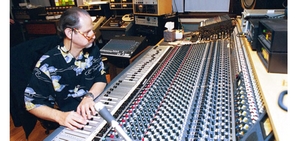
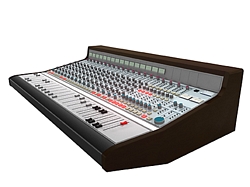
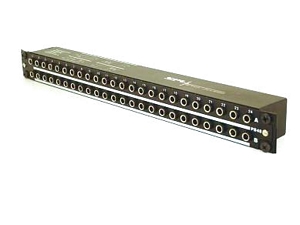 Patchbay
Patchbay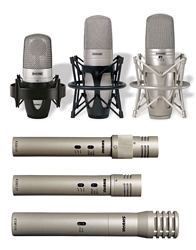
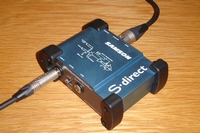 DI Box
DI Box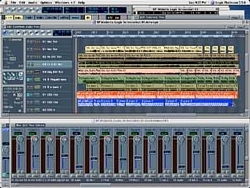 DAW = Digital Audio Workstation
DAW = Digital Audio Workstation